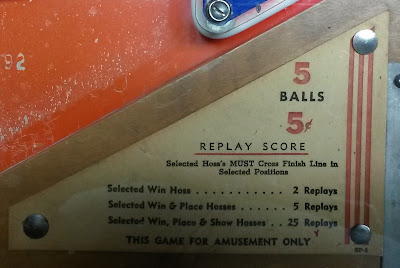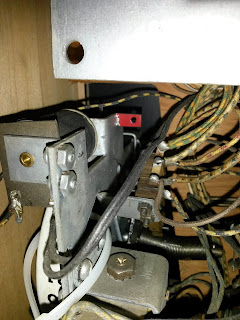Maybe it's cabin fever from self isolating, but lately I've been playing this game a lot. Maybe it's from recently repairing and playing a Gottlieb contemporary of Spark Plugs... Chinatown. Games from that ear have their distinctive feel to them.
I just have this... I wouldn't say fixation, but interest for electro-mechanical horse racing games lately (not the pure mechanical ones tho).
I have Spark Plugs on the "B side" of the basement arcade. In normal times, I never think about this game, but these are not normal times.
Spark plugs has inverted impulse flippers. I like those. They give a whole other dimension to the flipper thing, you need to time your shots and flip wisely. Also, you can play the game one handed for ease of beverage consumption.
I just love seeing those cardboard nags advance step by step every time their respective pop bumper (or rollover) is hit.
Spark Plugs and Sea Jockeys share the distinction of having Win, Place and Show selections. Selections are pseudo randomised as the game starts during the reset cycle. Selections are changed with top center rollover also. Your selections need to cross the finish line in order to keep playing and win replays.
I really like the 3 selection feature, it adds a bit of a challenge once you get the first horse across the finish line, you want to keep playing and win more replays.
Win selection across the finish line scores 2 replays.
Place selection second across the finish line scores an additional 3 replays.
Show selection across the finish line third scores and additional 20 replays.
For a grand total of 25 replays.
All other horses crossing the finish line at any time during the game ends game.
25 Replays! That's not much compared to the bingo machines of the same era. However, I heard rumors that back in the day those horsey games were used for betting. Patrons would put money on on a horse with someone playing the game. Off game betting? That's possible...
The machine does have panel score display, but these scores are useless really.
The machine doesn't have a mechanical replay display. But the colored dots at the top of the backglass are backlit panels displaying the number of replays. On the underside of the cabinet. There's a knock off button.
I've had this game for a long time, since 2013... I was a different dude then... I was married, more hair, less beard and a lot less coin operated devices. Time flies! This game is rough cosmetically! But it works great, I've gone over this game a couple of times over the years.
Williams produced a bunch of horsey games in the early to mid 50's
Hayburners
Nags
Jalopy
Spark Plugs
Sea Jockeys
Horsefeathers
Handicap
Daffy Derby
...a few in the 60's
Nags
Derby Day
Hayburners II... which can seen in the Yello masterpiece Pinball Cha Cha
...and the early 70's
Winner, here the horses were moved under the playfield

















































